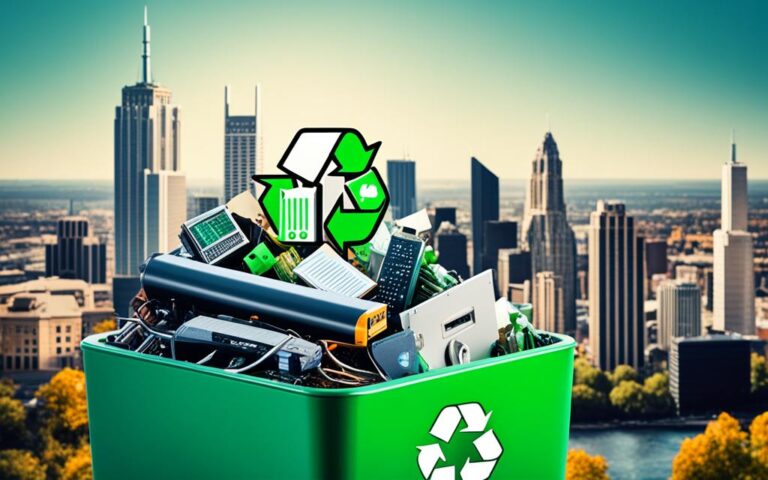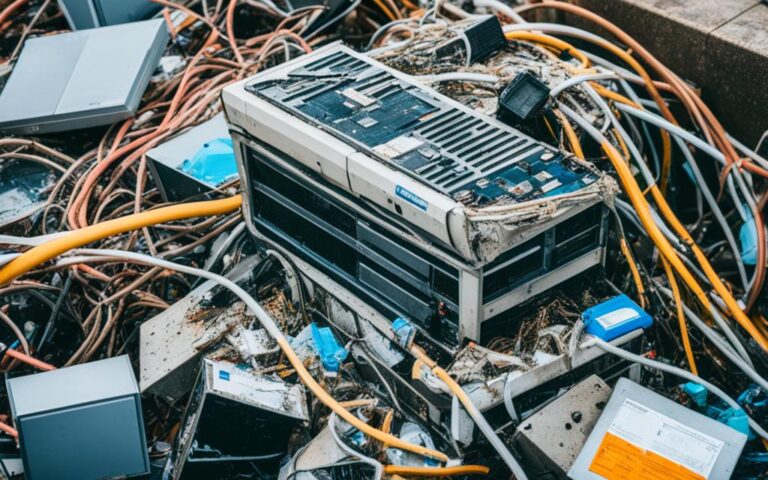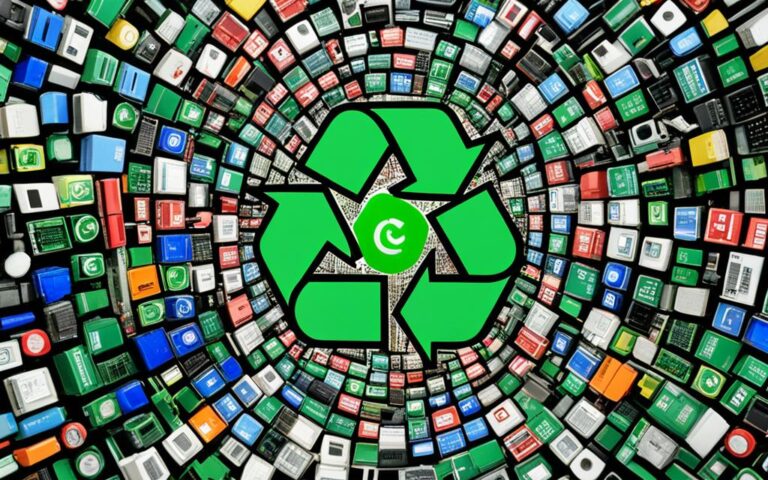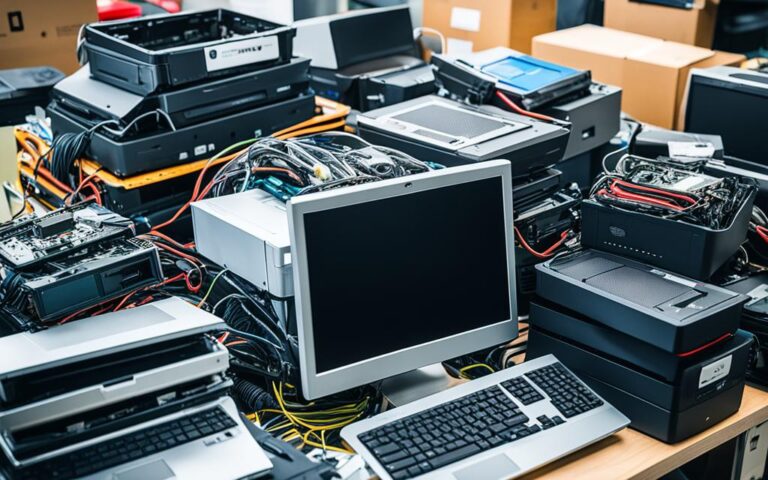The Circular Economy: A New Vision for Computer Recycling
When it comes to computer recycling, the circular economy offers a fresh perspective that embraces sustainability in the United Kingdom. Unlike traditional recycling methods, the circular economy focuses on minimizing waste by reusing packaging, products, and raw materials. This approach, which aligns with nature’s cycles, goes beyond reducing waste and aims to create a more environmentally friendly and equitable economic system.
In a world where electronic waste is a growing concern, the circular economy provides new possibilities for addressing the issue. By adopting this vision, the UK can contribute to reducing the amount of e-waste generated and promote a more sustainable future. The integration of circular economy principles in computer recycling is crucial for minimizing the environmental impact of our digital consumption and fostering a greener economy.
To truly understand the circular economy and its significance in computer recycling, it is essential to explore its core principles and how they can be applied to the ICT industry. By prioritizing reuse, repair, refurbishment, and recycling of products and materials, the circular economy aims to keep resources in use for as long as possible. This shift in mindset is essential for reducing waste and promoting efficient resource management.
Understanding the Circular Economy
The circular economy is a concept that aims to eliminate waste by keeping resources in use for as long as possible. It goes beyond traditional recycling by prioritizing reuse, repair, refurbishment, and recycling of products and materials. The goal is to design products and materials in a way that allows them to be easily recovered and regenerated at the end of their lifecycle. This shift towards a circular economy is crucial for reducing the environmental impact of production and consumption and promoting sustainability.
In a circular economy, the focus is on waste minimization and resource efficiency. Instead of following a linear “take, make, dispose” model, the circular economy emphasizes a closed-loop system where materials and products are continuously kept in use. This requires a shift in thinking from a consumption-driven approach to one that values durability, reparability, and recyclability.
By extending the lifespan of products through reuse, repair, and refurbishment, the circular economy reduces the demand for new resources and minimizes waste generation. It also encourages the development of innovative business models, such as product-as-a-service and sharing platforms, which promote the efficient use of resources and reduce the overall environmental impact.
The circular economy is a transformative approach that challenges the traditional “take, make, dispose” mindset and encourages businesses and consumers to rethink their role in the lifecycle of products and materials.
Furthermore, the circular economy offers numerous benefits beyond waste minimization. It can stimulate job creation, drive economic growth, and enhance resource security. By closing the loop on materials, the circular economy reduces the reliance on virgin resources, which are often extracted through environmentally damaging processes.
To illustrate the principles of the circular economy, consider the example of a smartphone. In a linear economy, the smartphone is manufactured, used for a period of time, and then discarded. However, in a circular economy, the smartphone could be designed for easy disassembly, allowing components to be reused or recycled. This would extend the lifespan of the device, reduce the demand for raw materials, and minimize waste.
Benefits of the Circular Economy:
- Reduces waste generation and landfill pollution
- Conserves natural resources
- Reduces greenhouse gas emissions
- Stimulates innovation and job creation
- Enhances resource security and reduces reliance on virgin materials
- Drives economic growth and promotes sustainable consumption
Embracing the principles of the circular economy is crucial for achieving long-term sustainability and addressing the environmental challenges we face. By shifting towards a circular economy, we can minimize waste, maximize resource efficiency, and create a more resilient and equitable future.
The Role of Circular Economy in ICT Equipment Recycling
The circular economy has immense potential in reducing the amount of e-waste generated by ICT equipment. Currently, around 50 million tonnes of e-waste are produced each year globally. Adopting a circular economy approach in ICT equipment recycling can help extend the lifespan of products, reduce dependence on virgin resources, and ensure the reuse of materials.
Benefits of Circular Economy in ICT Equipment Recycling
- Extended lifespan of products: By implementing repair, refurbishment, and upgrade programs, ICT equipment can be kept in use for longer periods, reducing the need for new devices and minimizing waste.
- Reduced dependence on virgin resources: Through recycling and reusing materials from old ICT equipment, the circular economy model reduces the extraction and consumption of finite natural resources.
- Improved resource efficiency: Circular economy programs prioritize the design of ICT products for recycling, making it easier to recover valuable materials and reduce the environmental impact of their production.
- Positive economic impact: By creating local recycling and refurbishment facilities, the circular economy generates new job opportunities, stimulates economic growth, and supports local communities.
By prioritizing repairability, upgradability, and design for recycling, the ICT industry can contribute to a more sustainable and circular economy. Embracing the principles of the circular economy not only reduces e-waste and conserves resources but also supports the transition towards a more environmentally friendly and equitable economic system.
“The circular economy offers a transformative approach to ICT equipment recycling, enabling us to maximize resource efficiency and reduce waste. By adopting circular economy principles, we can create a more sustainable and resilient future.” – Jane Green, CEO of SustainableTech Solutions
| Current Challenges in ICT Equipment Recycling | Solutions Provided by Circular Economy |
|---|---|
| High levels of e-waste generation | Promoting repair and reuse programs to extend product lifespans, reducing the overall amount of e-waste. |
| Dependency on virgin resources | Implementing recycling programs to recover valuable materials from old ICT equipment and reduce the need for extracting virgin resources. |
| Complexity of the recycling process | Designing ICT products with disassembly and easy-to-separate components, enabling efficient recycling and material recovery. |
| Limited consumer awareness | Raising awareness about the benefits of circular economy practices and educating consumers on proper disposal and recycling methods for ICT equipment. |
The Role of Artificial Intelligence in Waste Sorting
Artificial intelligence (AI), specifically waste sorting robots equipped with computer vision technology, is revolutionizing the recycling industry and accelerating the transition to a circular economy. Computer vision technology enables machines to interpret and understand the visual world, allowing for efficient and accurate waste sorting. AI-powered robots can quickly identify and sort different materials in a waste stream, increasing the efficiency and cost-effectiveness of recycling. This technology has the potential to significantly improve the recycling process and reduce the amount of waste that ends up in landfills.
By harnessing the power of AI and computer vision technology, waste sorting robots can precisely categorize and separate various types of recyclables, including plastics, metals, and paper. The advanced algorithms employed by these robots enable them to identify different materials based on their visual characteristics, such as shape, color, and texture. This level of accuracy ensures that the recyclables are correctly sorted and can be properly processed for recycling.
Moreover, AI-powered waste sorting robots are designed to work autonomously, minimizing the need for human intervention and potential errors. They can operate continuously and efficiently, handling large volumes of waste without fatigue. This not only saves time but also reduces labor costs and increases overall recycling productivity.
One of the key advantages of AI in waste sorting is its adaptability. The algorithms used in these robots can learn and improve over time, allowing them to adapt to changing waste compositions and new materials. This adaptability ensures that the waste sorting process remains effective and accurate, even as new packaging materials and recycling technologies emerge.
Not only does AI improve the efficiency and accuracy of waste sorting, but it also contributes to a more sustainable and environmentally friendly waste management system. By increasing recycling rates and minimizing the amount of waste sent to landfills, AI-powered waste sorting technologies help to conserve natural resources and reduce the carbon footprint associated with waste disposal.
The Impact of AI Robotics on the Recycling Process
Integrating AI robotics technology into the recycling process has the potential to revolutionize the industry, making it faster, more accurate, and highly efficient. By automating the picking and sorting process, AI robots streamline the recycling workflow, resulting in increased recycling outputs and reduced operational costs. This innovative combination of AI and robotics enhances the effectiveness of materials recovery facilities (MRFs) by enabling them to process and sort a wider range of recyclates, ultimately supporting the transition to a circular economy.
AI robotics technology brings unparalleled efficiency to the recycling process. With their advanced sensors and computer vision capabilities, AI robots can quickly and accurately identify different types of recyclable materials, such as plastics, metals, and paper. This enables them to segregate the recyclables into appropriate streams, optimizing the recycling workflow and minimizing contamination.
Moreover, AI robots can operate continuously without fatigue or human limitations, ensuring a consistent and uninterrupted recycling process. They can work around the clock, significantly increasing the overall efficiency and productivity of MRFs. With AI robotics, the recycling industry can meet the growing demand for sustainable waste management by processing larger quantities of recyclables in less time.
The accuracy of AI robotics technology is another crucial advantage in the recycling process. With their sophisticated algorithms and machine learning capabilities, AI robots continuously learn and adapt to different materials and sorting challenges. This enables them to consistently achieve high accuracy rates in identifying and classifying recyclables, reducing manual intervention and potential errors.
Furthermore, the integration of AI robotics technology in MRFs allows for real-time data collection and analysis. AI robots can gather valuable insights about the composition and quality of recyclables, helping MRFs optimize their operations and make informed decisions. This data-driven approach enhances the overall efficiency of the recycling process, ensuring that valuable resources are properly recovered and channeled back into the circular economy.
By embracing AI robotics technology, the recycling industry can unlock new levels of efficiency, accuracy, and productivity in the quest towards a circular economy.
Although AI robotics technology is still evolving, its potential to transform the recycling process is undeniable. As advancements continue to be made, AI robots will become even smarter, more agile, and better equipped to handle complex sorting challenges. The integration of AI and robotics in the recycling industry is a crucial step towards achieving a sustainable, waste-free future.
Benefits of AI Robotics in Recycling:
- Increased sorting efficiency
- Improved accuracy in identifying recyclables
- Optimized use of resources
- Reduced operational costs
- Real-time data collection and analysis
- Enhanced productivity and throughput
Table: AI Robotics in the Recycling Process
| Benefits | Description |
|---|---|
| Increased sorting efficiency | AI robots automate the sorting process, ensuring faster and more efficient recycling. |
| Improved accuracy in identifying recyclables | With advanced computer vision technology, AI robots accurately identify and classify different types of recyclables. |
| Optimized use of resources | AI robots maximize the recovery of valuable resources, reducing waste and promoting sustainability. |
| Reduced operational costs | By automating the recycling process, AI robots lower labor and operational expenses for materials recovery facilities. |
| Real-time data collection and analysis | AI robots gather valuable data on recycling operations, enabling MRFs to make data-driven decisions for optimization. |
| Enhanced productivity and throughput | AI robots work continuously and efficiently, increasing the overall productivity and throughput of the recycling process. |
Conclusion
The circular economy offers a new vision for computer recycling, promoting sustainability in the United Kingdom and beyond. By adopting a circular economy approach, the ICT industry can play a significant role in reducing e-waste and maximizing the reuse of materials. This transformative approach goes beyond traditional recycling methods and embraces a holistic approach to managing resources and minimizing waste.
With the integration of artificial intelligence (AI) and robotics technology in the recycling process, the efficiency and effectiveness of waste sorting can be significantly enhanced. AI-powered robots equipped with computer vision technology can quickly and accurately sort different materials in a waste stream, increasing recycling outputs and reducing reliance on landfills. This technology revolutionizes the recycling industry and accelerates the transition towards a circular economy.
Embracing circular economy principles in computer recycling is crucial for fostering sustainability and minimizing the environmental impact of our digital consumption. By designing products and materials for repairability, upgradability, and recyclability, the ICT industry can contribute to a more sustainable future. Additionally, individuals and organizations can make a difference by responsibly disposing of electronic waste and supporting initiatives that promote circular economy practices.
To learn more about sustainable server recycling in the UK, visit Server Recycling UK. Together, we can create a more environmentally friendly and equitable economic system by embracing the circular economy and promoting computer recycling that prioritizes sustainability.
FAQ
What is the circular economy?
The circular economy is a concept that aims to eliminate waste by keeping resources in use for as long as possible. It prioritizes reuse, repair, refurbishment, and recycling of products and materials.
How does the circular economy contribute to computer recycling?
The circular economy offers new possibilities for reducing waste and fostering sustainability in the United Kingdom. By embracing this vision, the UK can address the growing concern of e-waste and contribute to a more environmentally friendly and equitable economic system.
What is the role of the circular economy in ICT equipment recycling?
The circular economy has immense potential in reducing the amount of e-waste generated by ICT equipment. By prioritizing repairability, upgradability, and design for recycling, the ICT industry can contribute to a more sustainable and circular economy.
How does artificial intelligence revolutionize waste sorting in the circular economy?
Artificial intelligence, specifically waste sorting robots equipped with computer vision technology, enables efficient and accurate waste sorting. AI-powered robots can quickly identify and sort different materials in a waste stream, improving the recycling process.
What is the impact of AI robotics on the recycling process?
AI robotics technology improves the efficiency of materials recovery facilities (MRFs) by automating the picking and sorting process. This allows for better segregation of recyclables, increasing recycling outputs and lowering operational costs.
Why is embracing the circular economy important for computer recycling?
Embracing the circular economy approach is crucial for fostering sustainability and minimizing the environmental impact of our digital consumption. It allows for the reduction of e-waste and maximizes the reuse of materials, contributing to a more sustainable future.
No, computer recycling goes beyond traditional recycling. It also involves reusing packaging, products, and raw materials to minimize waste.
The circular economy aligns with nature’s cycles by aiming to keep resources in use for as long as possible, similar to how natural systems operate.
The circular economy reduces the environmental impact by prioritizing reuse, repair, refurbishment, and recycling of products and materials, minimizing the need for new resource extraction and production.
Currently, around 50 million tonnes of e-waste are produced each year globally.
Adopting a circular economy approach in ICT equipment recycling extends the lifespan of products, reduces dependence on virgin resources, and ensures the reuse of materials.
Computer vision technology enables AI-powered robots to interpret and understand the visual world, allowing for efficient and accurate waste sorting.
AI robots can contribute to the circular economy by quickly identifying and sorting different materials in a waste stream, increasing recycling efficiency and reducing waste.
AI robotics enhance the effectiveness of recycling in MRFs by automating the sorting process, allowing for the processing and sorting of a wider range of recyclables.













